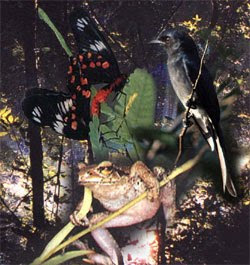Climate and Seasons in Sri Lanka
Sri Lanka Lies between 6 - 10 of North Latitude and Between 80 - 82 of East Longitude. It has a Maximum Length of 432 km (Devundara to Point Peduru) and Maximum Breadth 224 km (Colombo - Sangamankanda) . The Land Area is 65,525 Sq. km. The Area Excluding the Inland Water 62,336 Sq. km. The hills appear in the center and the south of Center. Sri Lanka is generally a warm country.
Sri Lanka has no marked seasons. A special feature is that the hot and humid lowlands and the salubrious hill country are separated by a few hours motoring.
Average mean temperature along the coast is 26.7 C (80 F) and 19.7 C (66.50 F) in the hill country. In Colombo, the commercial capital, situated on the west coast, the temperature varies from 26.4 C (79.5 F) to 27.8 C (82.12 F). Relative Humidity varies from 70% during the day to 90% at night. In the lowlands the climate is typically tropical with an average temperature of 27OC in Colombo. In the higher elevations it can be quite cool with temperatures going down to 16OC at an altitude of nearly 2,000 meters. Bright, sunny warm days are the rule and are common even during the height of the monsoon - climatically Sri Lanka has no off season. The south west monsoon brings rain mainly from May to July to the western, southern and central regions of the island, while the north-east monsoon rains occur in the northern and eastern regions in December and January.
Annual Rainfall Map of Sri LankaAnnual 2540 mm to over 5080 mm in south west of the Island. Less than 1250 mm in the north west and south east of the Inland.
Map of Sri LankaAnnual 2540 mm to over 5080 mm in south west of the Island. Less than 1250 mm in the north west and south east of the Inland.
Rainy Seasons
South West Monsoon- May to August
North East Monsoon- November to February
Yala (Ruhuna) National Park
Wilpattu National Park
Sinharaja virgin forest

Flora of Sinharaja

Out of the 211 woody trees and lianas so far identified within the reserve 139 (66%) are endemic. Similarly, high levels of endemism are perhaps true for the lower plants like ferns, epiphyts as well.out of 25 general endemic to Sri Lanka 13 are represent in Sinharaja. The Total vegetation density, including trees, shrubs, herbs and seedlings has been estimated to be around 240,000 individuals per hectare, of which 95% comprise individuals of the ground layer bellow 1m in height.The density of trees, lianas above 30 cm girth at breast height, ranges between 600 700 individuals per hectare while the number of merchantable individuals of trees of girth grater than 150cm ranges between 45-55 individuals per hectare.
Fauna of Sinharaja
Out of the Birds recorded in the western sector of the reserve, 72% were resident non-endemic and 13% migrants. One of the most interesting and colorful spectacles to be found in the in the Sinharaja is the presence of mixed species of foraging bird flocks, a phenomenon commonly found in rain forests total of 100 such flocks were systematically observed, and studies have revealed that some flocks contained 48 species including 12 endemic species. The rare endemic birds to be seen in Sinharaja are the Red-faced Malkoha, the Sri Lanka Blue Magpie, the Ashy-headed Barbbler, and the White - headed Starling and the Green billed Coucal the rarest of Sri Lankan birds. The Agamids are the best represented group of reptiles, the most common being the Green Garden Lizard. Of Special significance are the sightings of Calotes Liolepis an arboreal species, the rearest of all agamids found in the island .The only Tortoise recorded in the reserve is the Hard - shelled Terrapin, while of the species of skinks, the spotted skink can be seen often. Among the snakes The Green Pit Viper and Hump-nosed Viper are commonly found in this forest and are endemic to Sri Lanka.The amphibians are fairly well represented in the reserve and nine endemic species have been identified. The endemic Torrent toad and the common house toad. In most streams and marshes, the Wrinkled frog and The Sri Lankan Reed frog is also found in Sinharaja. Ramanella palmata a rare endemic species is the only microhylid recorded so far while the yellow-banded Caecilian is the only apodan recorded.It is desirable that you, who visit the forest, be sensitive to the need to conserve forests such as Sinharaja.Contray to the chaos and congestion prevailing in urban areas, it is in forests that the quality of life is best expressed. In addition man finds peace and tranquillity in forest.Allow yourself sufficient time to roam about within this natures green cathedral and enjoy its beauty and majesty whether you be a photographer, artist, scientist or a nature lover. Please leave it as you find it is our humble request









No comments:
Post a Comment